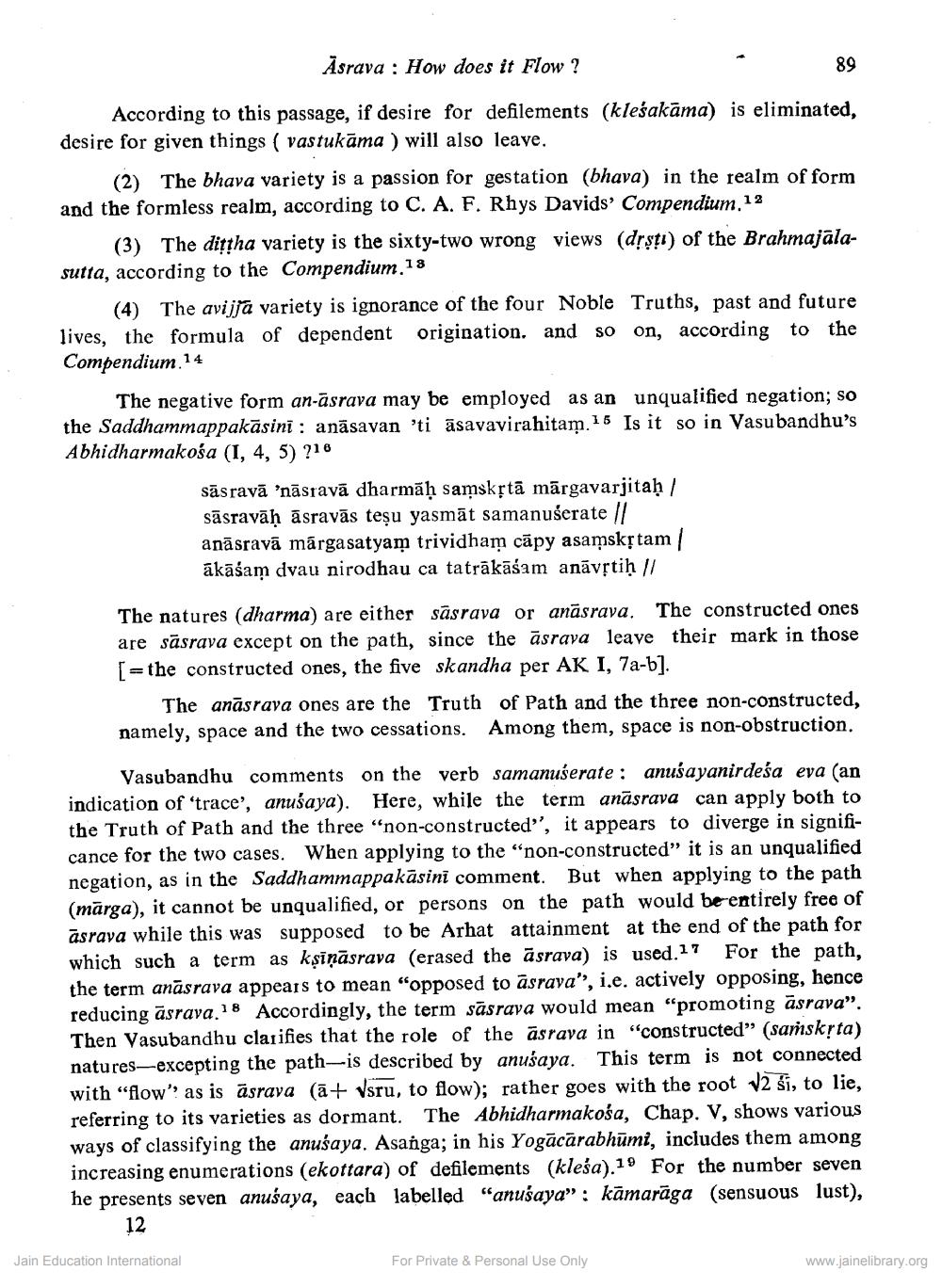Book Title: Asarva how does it flow Author(s): Alex Wayman Publisher: Z_Aspect_of_Jainology_Part_3_Pundit_Dalsukh_Malvaniya_012017.pdf View full book textPage 2
________________ Asrava : How does it Flow ? 89 According to this passage, if desire for defilements (klesakāma) is eliminated, desire for given things ( vastukāma ) will also leave. (2) The bhava variety is a passion for gestation (bhava) in the realm of form and the formless realm, according to C. A. F. Rhys Davids' Compendium, 12 (3) The dittha variety is the sixty-two wrong views (drsti) of the Brahmajalasutta, according to the Compendium. 18 (4) The avijja variety is ignorance of the four Noble Truths, past and future lives, the formula of dependent origination, and so on, according to the Compendium. 14 The negative form an-āsrava may be employed as an unqualified negation; so the Saddhammappakāsini : anāsayan 'ti āsavavirahitam.15 Is it so in Vasubandhu's Abhidharmakośa (1, 4, 5) ?16 sāsravā 'nāsravā dharmāḥ samskstā mārgavarjitaḥ / sāsravāḥ āsravās teșu yasmāt samanuśerate // anāsravā mārgasatyam trividham cāpy asamskstam ākāśam dvau nirodhau ca tatrākāšam anāvștiḥ 11 The natures (dharma) are either sāsrava or anāsrava. The constructed ones are säsrava except on the path, since the āsrava leave their mark in those [= the constructed ones, the five skandha per AK I, 7a-b]. The anāsrava ones are the Truth of Path and the three non-constructed, namely, space and the two cessations. Among them, space is non-obstruction. Vasubandhu comments on the verb samanuśerate : anuśayanirdeśa eva (an indication of 'trace', anuśaya). Here, while the term anāsrava can apply both to the Truth of Path and the three "non-constructed”, it appears to diverge in significance for the two cases. When applying to the “non-constructed” it is an unqualified negation, as in the Saddhammappakāsini comment. But when applying to the path (märga), it cannot be unqualified, or persons on the path would be entirely free of asrava while this was supposed to be Arhat attainment at the end of the path for which such a term as kşīņāsrava (erased the asrava) is used. 17 For the path, the term anāsrava appears to mean "opposed to asrava', i.e. actively opposing, hence reducing āsrava 18 Accordingly, the term sāsraya would mean "promoting asrava". Then Vasubandhu clarifies that the role of the asrava in "constructed” (saṁskṛta) natures-excepting the path-is described by anuśaya. This term is not connected with "flow" as is ásrava (āt vsru, to flow); rather goes with the root 12 si, to lie, referring to its varieties as dormant. The Abhidharmakośa, Chap. V, shows various ways of classifying the anuśaya. Asanga; in his Yogācārabhūmi, includes them among increasing enumerations (ekottara) of defilements (klesa).19 For the number seven he presents seven anuśaya, each labelled "anuśaya": kāmarāga (sensuous lust), 12 Jain Education International For Private & Personal Use Only www.jainelibrary.orgPage Navigation
1 2 3 4 5 6 7 8
